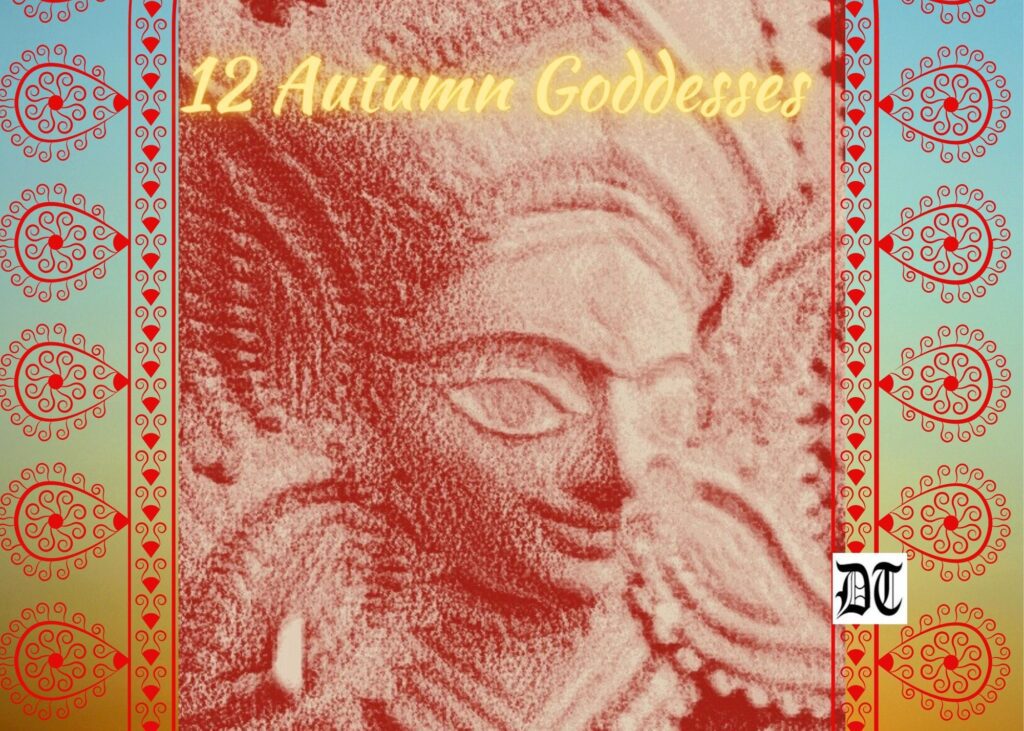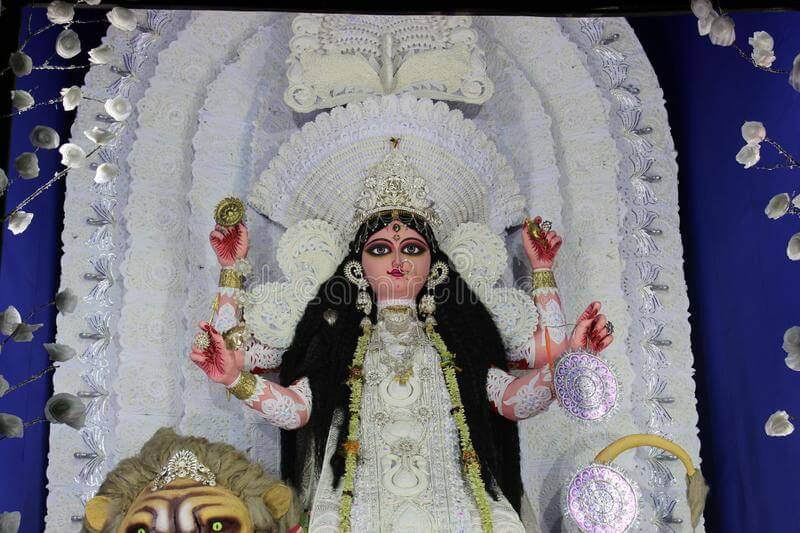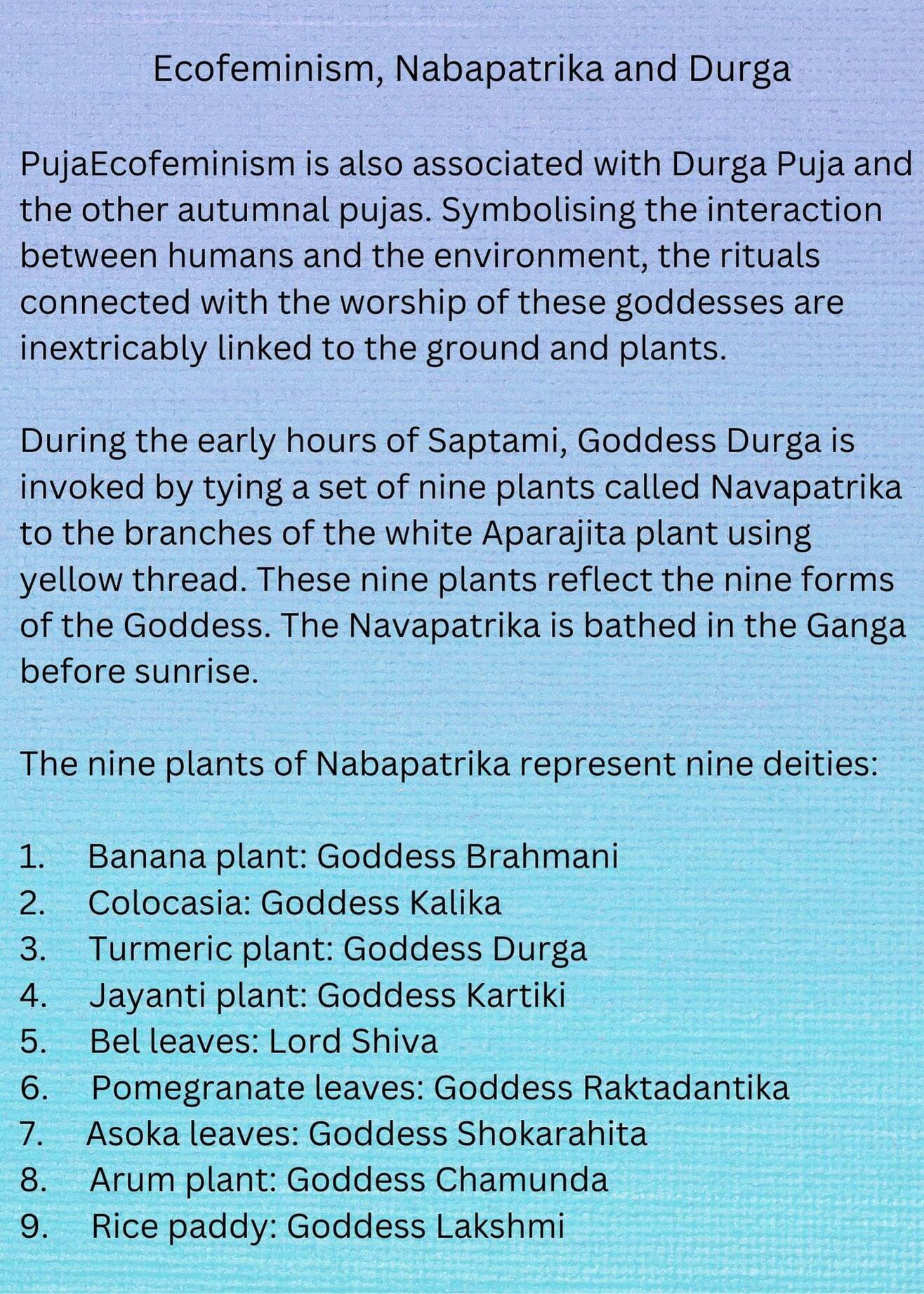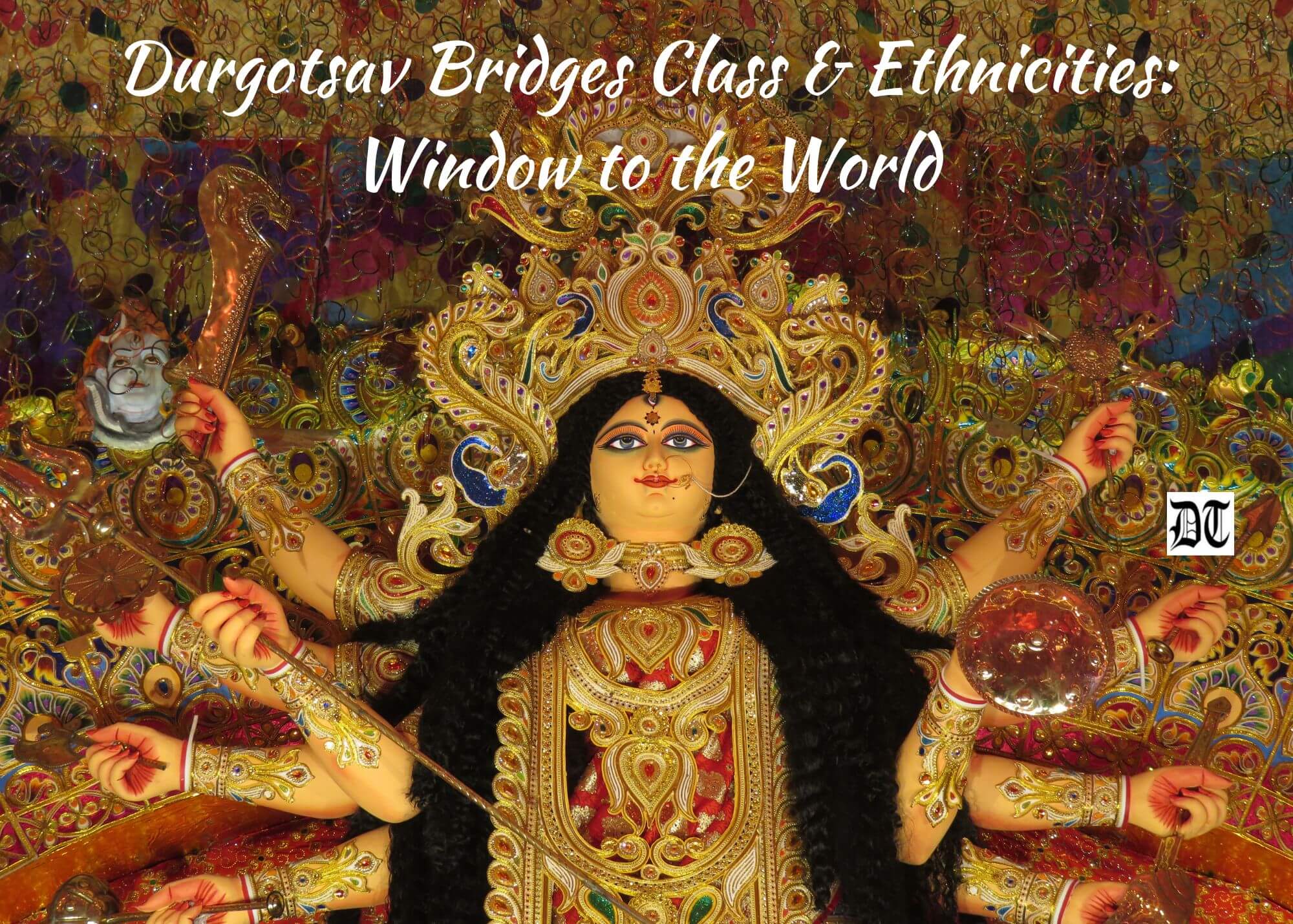Reading Time: 8 minutes
Durgotsav represents the Mother Worship, an ancient legacy. UNESCO has awarded West Bengal Durga Puja the heritage tag, making it the first Asian festival with prestigious recognition. Rituparna elucidates the 12 Autumn Goddesses invoked now – an exclusive in the Special Feature for Different Truths.

The first Asian festival to obtain the coveted UNESCO World Heritage designation is the festival of fervour, pomp, pleasure, and community, which celebrates the triumph of virtue over evil. Yes, our Durga Puja is the glory of Bengal and India’s cultural legacy.
According to UNESCO, “Durga Puja is seen as the best instance of the public performance of religion and art, and as a thriving ground for collaborative artists and designers. During the event, the divides of class, religion and ethnicities collapse as crowds of spectators walk around to admire the installations.”
This is a celebration of strength, the triumph of good over evil. This is a festival of love, faith, and unity in which individuals of all religious beliefs, castes, and communities are included in celebrating humanity’s legacy. Durga Puja has transcended all religious intolerance in its real essence. UNESCO has elevated this to the peak of the cultural heritage platform of pride and dignity.
Durga Puja is India’s window to the world, revealing many tales from Hindu mythology.
Durga Puja is India’s window to the world, revealing many tales from Hindu mythology. However, Durga is not the only symbol of the cosmic force mentioned in this text. It focuses on the divine in all her manifestations and avatars. They are the Autumnal Goddesses; Durga in her nine incarnations of Shailaputri, Brahmacharini, Chandraghanta, Kusmanda, Skandamata, Katyayan, Kalraatri, Mahagauri and Siddhidatri. They are all different manifestations of Durga, the immortal Goddess. Durga disguised herself in these nine forms to confuse Mahisasura, and she ultimately succeeded in killing him to end all sin.
On the first day of Navaratri, Shailaputri, the daughter of Himalaya, is worshipped. She rides a bull and holds a trident and a lotus flower in her two hands. She embodies the deities Brahma, Vishnu, and Shiva.
Brahmacharini, venerated on the second day of Navaratri, demonstrates pious abstinence. She is joyful and bestows happiness, serenity, prosperity, and grace while holding a rosary in her right hand and a Kamundal (watering vessel) in her left. She embodies Durga and has remarkable abilities. Moksha is the means to liberation.
Chandraghanta, the third aspect of Goddess Durga, is venerated on the third day of Navaratri, and she bestows tranquilly and prosperity upon us. She flaunts a Chandra or half-moon on her forehead as a bell or ghanta and mounts a lion with a lovely, golden complexion. She has ten hands, and three eyes are equipped with weapons representing valour in her battle against demons.
Kusmanda, the fourth incarnation of the Mother Goddess, is the cosmic egg.
Kusmanda, the fourth incarnation of the Mother Goddess, is the cosmic egg. Therefore, she is the universe’s creator. She mounts a lion, and her eight hands are adorned with weapons. The cosmos was vacant and filled with darkness until she dispersed her lights in all directions.
Skanda Mata is the fifth aspect of Durga, the mother of Skanda or Lord Kartikeya, whom the gods picked to lead them against the demons. She has three eyes and four arms. On the fifth day of worship, she is joined by child Skanda, whom she holds in her right upper arm.
Kathyayini is the sixth Mother Goddess incarnation. There is a tale behind her name: once upon a time, a wise man named Kata had a son named Katya. To obtain the favour of Mother Goddess, he undertook austerities and penance. Kathyayini was born as an incarnation of Durga when Goddess granted his yearning for a daughter.
Kalratri is the seventh incarnation of Durga, characterised by dark skin, dishevelled hair, a lightning-flashing necklace, and a courageous stance. She is mounted on a donkey. She has three brilliantly glowing eyes, and her breath emits terrifying flames. She provides devotees boons with her outstretched right hand while her lower right hand is in a position of calming worries. Her protective gesture guarantees us independence from fear and problems. She is also known as Shubankari, which means benefactor.
The eighth incarnation, Mahagauri, has unwavering and instantaneously rewarding potency.

The eighth incarnation, Mahagauri, has unwavering and instantaneously rewarding potency. Her worship cleanses all past, present, and future sins. She obtained a dark complexion due to her prolonged spartan lifestyle in the dense forest. Lord Shiva purified her with water from the Ganges, and her body recovered its beauty and became renowned as the white Mahagauri. She is mounted on a bull. She has four hands: one carrying a trident, another a damru, a third to dispel fear, and a fourth to bless her believers.
Siddhidatri is venerated on the ninth and last day of Navaratri. She has miraculous healing abilities. She is mounted on a lion. She embodies pleasure and contentment, blesses all gods’ saints, and is devoted to the Mother Goddess. Due to her blessings, half of Lord Shiva’s body turned feminine while the other half remained male in the incarnation of Ardhanarsihwara.
If these nine aspects of Durga are worshipped with religious fervour, it is thought that spiritual fulfilment would result. On the tenth day, Vijaya Dashami or Dussehra is observed.
The narrative does not finish here. In Hindu mythology, other Autumnal Goddesses enhance the splendour of the Mother Goddess.
Sharad Purnima is celebrated as Kojagari Lokkhi (Lakshmi) Puja in several regions of India.
Sharad Purnima is celebrated as Kojagari Lokkhi (Lakshmi) Puja in several regions of India, including West Bengal, Assam, portions of Odisha, and eastern Bihar. It is performed on the night of the full moon, five days following Durga Puja. Maa Lokkhi, as in Bengali or Lakshmi, the Goddess of riches, is characterised as Chapala, or capricious; hence, worshippers worship Lakshmi to obtain her favour and favours. Over time, Kojagari Lakshmi Puja has become a significant gathering and greeting event.
Kojagari Lakshmi Puja is usually performed at night or in the evening. According to folklore, the Goddess Lakshmi blesses those who worship her at night by visiting their homes. Kojagari is derived from the Bengali phrase “Ke jago re,” which translates to “who is awake”; the Goddess is believed to visit residences where she is worshipped that night. Kojagari Lakshmi Puja is associated with the harvest season, during which farmers pray for a prosperous harvest. In many homes, instead of an idol, a clay or metal pot filled with rice grains is worshipped as Lakhsmi.
The festival of Kalika or Kali symbolises late Autumn. She is also known as Chaturbhuja Kali, Chinnamast, and Kaushika. Kali’s name stems from the Sanskrit meaning “she who is dark” or “she who is dead.” As the personification of time, Kali devours all things; she is irresistibly alluring to humans and gods. She may also symbolise the beneficence of a mother goddess, especially in later traditions. In eastern and southern India, notably in Assam, Kerala, Kashmir, and Bengal, the Goddess (Devi) is revered.
There are various legends about the origin of Kali.
There are various legends about the origin of Kali. In one account, the ten-armed, weapon-wielding warrior goddess Durga, who rode a lion or tiger in combat, battled the buffalo demon Mahishasura (or Mahisa) while mounted on a lion or tiger. Durga got so infuriated that the shape of Kali sprang from her forehead. Once born, the dark Goddess devoured all the demons she encountered, hanging their severed heads around her neck. People and gods were at a loss for what to do in the face of Kali’s fierce onslaught, which now included all wrongdoers. Fortunately, Shiva halted Kali’s destructive rampage by laying in her path, and when Kali realised that she was standing on Shiva, she eventually calmed down. This tale explains Kali’s link with battlefields and sites where cremation occurs.
In another story of the Goddess’s birth, Kali arose when Parvati shed her black skin, which subsequently transformed into Kali; consequently, one of her titles is Kaushika (the Sheath), while Parvati is referred to as Gauri (the Fair One). This myth emphasises Kali’s blackness, symbolising endless darkness that has both destructive and creative power.
Jagatdhatri is the twelfth of the great, bold, forceful, kind, and all-giving Autumnal Goddesses.
Jagatdhatri is the twelfth of the great, bold, forceful, kind, and all-giving Autumnal Goddesses, and she is venerated during the chilly last days of Autumn.

Jagadhatri puja honours the “Mother” who maintains the cohesion of the universe. The three-eyed Goddess on an elephant represents the deceased demon Karindrasura. She mounts a lion and carries a conch, a bow, an arrow, and a chakra in her four hands. As a manifestation of the goddess Durga, Jagadhatri also embodies Shakti. According to legend, following the defeat of Mahisasura, all devatas turned egocentric. They believed that Goddess Durga could only slay the monster with the weapons provided by the devas. They did not comprehend the significance of the fundamental force in the triumph.
Brahma came in the shape of Yaksha in front of the devas so that they would recognise their errors. He asked the gods to relocate a glass blade. Vayu, the deity of wind, said that if he could uproot massive mountains and forests, he could undoubtedly transport a blade of grass. But despite His efforts, he was unsuccessful. A similar fate awaited Agni, the god of fire, whose ability to consume almost everything did not affect the grass blade. The other gods followed suit one by one. They quickly realised that their strength alone was meaningless. Their power was taken from the might of Maa Jagadhatri, the Supreme Mother who keeps the whole universe together. As this realisation dawned upon them, their ego transformed into an elephant. Mother Adi Shakti materialised in front of them as Jagadhatri.
Sri Ramakrishna said, “Jagaddhatri occurs in the heart of one who can subdue the mind’s unruly elephant.” It is claimed that anybody who worships Maa Jagadhatri with dedication loses their feeling of self-importance. Then, he becomes the servant of Brahman, which reveals itself across the whole Brahmanda or Creation.
Sri Krishna states in Chapter 5, Verse 13 of the Bhagavad Gita:
sarva-karmāṇi manasā sannyasyāste sukhaṁ vaśhī
nava-dvāre pure dehī naiva kurvan na kārayan
It means, “The embodied creatures who are self-controlled and detached live blissfully in the city of nine gates, free from the belief that they are the agents or the cause of everything.”
The only way a person may attain self-control and detachment is by mastering his mind or ego, the “elephant” upon which Maa Jagadhatri proudly sits.
Chandannagar, West Bengal, celebrates Jagadhatri Puja with much pomp and ceremony.
Chandannagar, West Bengal, celebrates Jagadhatri Puja with much pomp and ceremony. In 1754, however, Maharaja Krishna Chandra of Krishnanagar initiated the festival. According to legend, the Goddess arrived in the Maharaja’s dream as a young girl and requested that he worship Her in the form she decided to take. Then She turned into a goddess, flooding the universe with light as She sat on a lion while carrying a conch, chakra, and bow and arrow.
From the end of September until the start of November, they are harbingers of peace, prosperity, love, happiness, and other forms of contentment and fulfilment. However, the narrative does not finish here.
These deities are intertwined with our nation’s rich cultural history.
These deities are intertwined with our nation’s rich cultural history. The festivities are also tied to the economics of the culture, embracing and employing a wide range of employees in the creation of idols, decorations for the Goddesses, dhakis banging dhaks (stick-played drums), decorators and pandal makers, florists, priests, and others. Puja festivities are the period of festivals when petty employees, daily wage earners, and other disadvantaged strata of society get little wealth. This is an extraordinary advantage of pujas.
In addition, entertainment is the most critical factor; individuals from all social classes, with their various resources, join wholeheartedly to seek blessings from the Goddesses, who are all symbols of cosmic power. These days, the Durga puja and its attendant rituals are more secular than religious. No wonder UNESCO picked Durga Puja as the torchbearer of World heritage, the first of its type in Asia, the window to the world of our diverse culture and adorned history.


References
- 1. 20is%20considered%20to,Indian%20festival%20to%20do%20so
- 2. https://www.unesco.org/en/articles/durga-puja-inscribed-unesco-representative-list-intangible-cultural-heritage-humanity
- 3. https://www.thestatesman.com/durga-puja/durga-puja-unesco-intangible-cultural-heritage-1503107424.html
- 4. https://www.wordzz.com/nava-durga-the-nine-forms-of-goddess-durga/
- 5. https://www.ndtv.com/india-news/sharad-purnima-2020-kojagori-lakshmi-puja-significance-and-special-bhog-2317476
- 6. https://www.worldhistory.org/Kali/
- 7. https://krishnabhumi.in/blog/jagadhatri-puja-origin-and-significance/
- 8. https://www.freepressjournal.in/cmcm/maha-saptami-2017-all-you-need-to-know-about-navapatrika-maha-snan-pranpratistha
Feture Picture Design by Anumita Roy, Different Truths
Insert pictures from wallpapers and dreamtime.com















